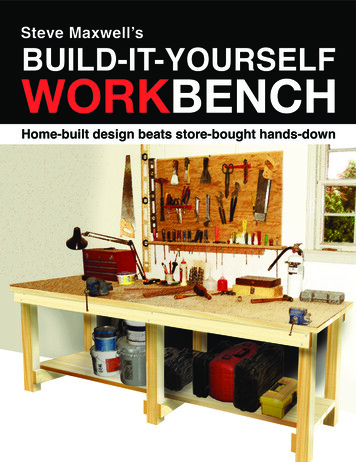
Transcription
Steve Maxwell’sBUILD-IT-YOURSELFWORKBENCHHome-built design beats store-bought hands-downCLICK FOR TABLE OF CONTENTS
WORKBENCHIf you’re interested in building self-reliance skills, a solidworkbench is key to growing your capabilities. In fact, it’seven more important than most of the tools you might use at abench. That’s because a good workbench makes so many jobseasier. Repairing small machines, assembling projects and building furniture are entirely dependent on a proper work surfaceof the right height. And the thing is, money can’t buy a decentworkbench. At least not at reasonable prices. If you want morethan a light-duty portable workstation – and you don’t feel likepaying big bucks for something that’s way fancier than you need– building your own workbench is really the only option. Learningexactly how to do this is what I’ll show you here.In the early 1980s I built my first serious workbench, and afterusing it nearly every day since then, I still call the design a success. That’s why I figure it’s worth passing on to you here. Youcan build your own version using standard construction-gradeplanks, or rough-cut lumber, as I did. Either way, you’ll get abench that’s heavy enough to be solid, simple enough for anyhandy person to build, and durable enough to last longer thanyou will.There are three main parts to my design: the top, the legs andthe storage shelf. But before you begin building, you need to dosome figuring. How long should your workbench be? How wide?How tall? Mine has a top that’s 9 feet long and 35" deep fromfront to back. That’s a generous size if you can accommodateit, but your bench needn’t be this big. You can go smaller (orlarger), depending on your needs and available space. The onlydimension that’s important is bench height. The rule of thumb forany woodworking bench is an overall height equal to the distancebetween your wrists and the floor as your arms hang looselyby your sides. A general-purpose bench for, say, sharpening achainsaw, fixing a broken toy or assembling a new gardenseeder should be taller. My old faithful bench is 35” from floor totop of the work surface.You’ll get a bench that’s heavy enough to be solid, simple enough for anyhandy person to build, and durable enough to last longer than you will.optional replaceable plywood top2 x 6 (or similar)top boards4 x 4 legs10” to 12”optionalraised side and backFRONT VIEW24” to 48”leg frame spacing3/8” x 6” carriage bolts,nuts and washers2x6long rails2x6crosspiecestwo 3 1/2” deck screws and glueSIDE VIEWshelfWORKBENCH2
WORKBENCHBUILD THE LEG FRAMESThe plans show how pairs of legs are joined together into frames,with the frames connected by the long rails, top boards and shelfboards. Your first task is to build as many of these leg frames asneeded to get the total length of bench you want. Depending onthe weight of things you’ll be putting on your bench, aim for 36" to48" between leg frames. If you’re not sure what makes sense rightnow, build the minimum number of frames you think will do thejob, then temporarily set some top and shelf boards in place andsee how things feel. You can always make an additional leg framebefore assembly if trial and error shows it’s necessary.You could use 2x4s for the legs, but 4x4s work better. Remember, a heavy bench is a good bench. Cut all the legs youneed to length in one go, and all the crosspieces. A mitre saw isan excellent tool for easily and quickly getting these cuts perfectly square, but you can use a handsaw or hand-held circular saw,too. With all the legs ready, it’s time to begin assembly, but firstlet me tell you about a trick to make this happen accurately.A sheet of plywood or OSB placed on the floor is an excellentreference tool for assembling your leg frames so they’re square.Since the corners of any sheet material are perfectly 90º, theyoffer ideal guides for positioning legs and cross pieces relativeto each other. Place one leg along one long edge of the plywoodas it sits on the ground, with the end of the bench leg alignedwith the corner of the sheet. Place a second leg parallel to thefirst one, with outer edges of the legs spaced to match the lengthof your cross pieces. The beauty of using sheet material as anassembly guide like this is that it ensures square leg frames.As long as the ends of both legs are aligned with the edges ofthe plywood, and both legs are parallel, leg frames will have 90ºcorners, guaranteed. Double check your frames by measuring diagonals taken across the corners. Square leg frames will alwayshave equal diagonals.Back when I built my workbench, there was no such thing asdeck screws. Wood screws available then were expensive andthey didn’t bite into wood like the best modern deck screws dotoday. That’s why I used nails for my bench. That said, you’ll befar better off to assemble your bench parts with deck screws.They hold better than nails and it’s easier to drive them. Myfavourite deck screws are called Spax. The version I use arehot-dipped galvanized for rust-free exterior use and they havewavy threads that bite aggressively into wood.Secure the cross pieces to the first pair of legs now. Theupper cross piece needs to be flush with the top of the legs, andthe second one 6" up from what will become the bottom ends ofRENEWABLE WORKBENCH TOPIf you’ll be using your bench for gluing or finishing wood,consider securing a replaceable layer of 1/4” underlayplywood on top. Use just enough small screws to keep theplywood secure. When the glue and mess get too much,simply remove the old ply and replace it with a fresh piece.ROUGH WOOD OR SMOOTH?Standard construction-grade lumber of the kind used tobuild houses measures 1 1/2” thick, and this is an excellentmaterial for a workbench top. If you live where small sawmillsare in operation, rough-cut lumber makes a terrific bench. It’stypically thicker than construction-grade lumber milled for thehomebuilding industry (1 3/4” to 2” instead of 1 1/2” thick),and depending on the species, this extra thickness probablywon’t cost any more. The only issue to keep your eye on ishow consistent the thickness of rough lumber is. Depending on the kind of mill used to saw the wood, rough lumberthickness can be quite consistent, or it can vary as much as1/4” from board to board. Planing one side and one face ofrough boards is the best way to make them consistent whileretaining the greatest wood thickness.the legs. Use two 3 1/2"-long deck screws and glue to hold eachjoint together. Assemble the other leg frames now, then comparethem all with each other when you’re done. If you’ve cut all theparts the same length, everything will be fine, though it pays todouble-check. Fixing errors now is much easier than later.ASSEMBLE THE BASENow’s the time to connect leg frames so they form the supportstructure for your bench, and long rails are the parts that makethis happen. Depending on the length and strength you’re aimingfor with your workbench, 2x4s or 2x6s are the thing to use forlong rails. Either way, these long rails fasten flush to the top ofthe legs. But before you begin assembling the base, let me tellyou about another important trick. It’s the easiest way to ensureyour leg frames come together properly. Forget your carpenterssquare, and grab a 24”-long level instead.Start by finding a flat and level floor surface to set all theleg frames upright on, or create a temporary level surface. Thesheet of plywood you used for assembling the leg frames willprobably work fine if it’s not warped. Either way, once you haveall leg frames on a level surface, all you need to do is make surethey’re straight up and down (called “plumb”) as the long rails arefastened. Do this in reference to the level and all connections willbe square. This is much easier and more accurate than using acarpenter’s square.Recruit a helper to hold the leg frames up and keep them inposition as you apply wood glue and secure each long rail-to-legjoint with a single deck screw, set off-center so you have roomfor a second screw later. You could certainly forget the glue, butit’s amazing how much strength and rigidity it adds. For all thetime it takes, why cut corners?Your bench won’t be very strong at this stage because the glueis still wet, but that’s okay. Check that the leg frames are all plumbone more time, then add a second screw to each joint. If you wantthe strongest possible bench, get out your drill and 3/8” diametercarriage bolts without wasting time. Bore holes and draw the jointsWORKBENCH3D
WORKBENCHtogether tightly with the bolts before the glue dries. Besides pullingthe joint together tightly for maximum glue strength, if things everloosen up as the wood dries and shrinks in the future, you cantighten up the joints as good as new with a wrench.ADDING THE TOPYou can build the top of your workbench with 3/4"-thick plywoodor solid 2x6, 2x8 or 2x10 lumber. I prefer to use planks herebecause they don’t cost any more than plywood, and they makefor a stronger, heavier bench. There’s also no need to cut any ofthe boards lengthwise to get a specific workbench top width. Youcan usually mix and match different standard widths of lumber todeliver the ideal 1" or 2" of overhang on the sides and ends. Asyou figure things out, remember that a construction-grade 2x6measures 5 1/2” wide; a 2x8 is generally 7 1/4"; and a 2x10 istypically 9 1/4" wideIf you’re using lumber for the top, make sure all boards arecut to the same length, then arrange them tightly as they comeVISE ADVICEAs useful as a good workbench is, you’ll also needto add some kind of vise to make the bench asuseful as possible. And the work you plan to doaffects the hardware that makes sense.A machinist’s vise with 6"-wide jaws is myfavourite all-around option for holding anythingmetal, plus wood and plastic where surface dentingdoesn’t matter.If you’ll be using your workbench primarily forwoodworking, then consider a face vise madeespecially for this job. It’s wider than a machinist’svise, and uses pieces of hardwood to form theworking faces of the jaws.POTTING BENCH AND SINKInsetting a removable potting tub or twointo the top of your bench is easy anduseful. Buy a sturdy plastic tub with alip, measure the length and width of thebody of the tub, then mark it on the benchtop, somewhere between leg frames onthe right or left hand side of the centerlegs. Use 2x4s to reinforce the undersideof the top immediately on each side wherethe tub will go, then bore a 1” diameterhole through the bench top, just insidethe lines, one at each corner. Cut all foursides of the opening using a jigsaw, thendrop the tub into position. You’re nowready to store soil or potting materialsright at bench level.If you’d like to add a sink and runningwater to your bench, you’ve got a coupleof options. You can install a sink the sameway as a potting tub, or inset it below thesurface so the sink can be covered witha removable piece of plywood when-WORKBENCH4ever you want a continuous benchtopwork surface. A reclaimed stainless steelkitchen sink is ideal for covering in thisway because the perimeter lip is thin. Cuta reinforced opening in the benchtop andinstall your sink as you would any pottingtub. Next, cut a piece of 3/4-inch plywoodthe same size as your workbench top, soit rests on the top boards, with an openingcut for the sink that’s as large as the outeredges of the sink’s lip. Cut a matchingpiece of 5/8”-thick plywood to fill thisspace and you’ve got a removable coverthat sits flush with the rest of the benchtopwhen you’re not using the sink.A reclaimed kitchen faucet is a moreconvenient way to bring water to your sinkthan a garden hose, and it’s not difficultto install. Fasten 6" or 7" lengths of 1/2"diameter copper pipe onto the inlets ofyour faucet if it doesn’t have any, then usefour copper pipe mounting straps to securethe faucet to the back face of the benchtopback. Fit the end of one of the copper pipescoming off the faucet with a quick-releasehose fitting, and it’s easy to connect anddisconnect the water supply to your bench.Drain waste water from the sink into a pailor a graveled area underneath the bench,and you’re ready to wash vegetables outdoors, keeping mess out of your kitchen.An optional raised back and sides on thebenchtop helps keep potting supplies andtools from rolling off during use.
WORKBENCHtogether on the leg frame. Gaps between boards aren’t whatyou want, since dirt and small tools will fall down onto the itemsstored on the shelf below. If you can get a couple of pipe clampsto draw the wood together, that’s perfect. If not, just pull the woodtight by hand while you fasten the boards to the cross pieces below. Two or three 3 1/2" or 4"-long deck screws driven into eachtop board-to-cross piece joint will do the job. Use no glue onthese joints, since you want the option of removing and replacingtop boards later, if they get damaged.FINISH WITH THE SHELFThe shelf is nothing more than a replica of the top, except thatit fits between the legs, not on top of them. And unless you’ll bestoring exceptionally heavy things, 3/4" plywood is fine for theshelf. Cut the shelf boards so they fit between legs, and fastenthem with screws only.Workbenches are one of those things that are best made, notbought. Take the time to build yours right and you’ll never needto wish you had a better bench again.COMPOSITE WORKBENCHIn 2002 I built an outdoor bench to support basketsof wet clothes and clothespins underneath ouroutdoor clothesline, and it hasn’t deteriorated a bitduring this time. Composite lumber is the reason why.The Trex I used isn’t as strong as wood, so the legframes need to be closer together. Other than that,a composite workbench is the perfect thing foryear-round, outdoor duty.WORKBENCH5
WORKBENCH together tightly with the bolts before the glue dries. Besides pulling the joint together tightly for maximum glue strength, if things ever loosen up as the wood dries and shrinks in the future, you can tighten up the joints as good as new with a wrench. ADDING THE TOP You can build the top of your workbench with 3/4"-thick plywood










